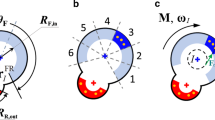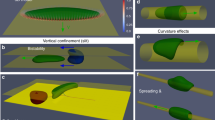Abstract
Cell motility is a fundamental physiological process that regulates cellular fate in healthy and diseased systems. Cells cultured in 3D environments often exhibit biphasic dependence of migration speed with cell adhesion. Much is not understood about this very common behavior. A phenomenological model for 3D single-cell migration that exhibits biphasic behavior and highlights the important role of steric hindrance is developed and studied analytically. Changes in the biphasic behavior in the presence of proteolytic enzymes are investigated. Our methods produce a framework to determine analytic formulae for the mean cell speed, allowing general statements in terms of parameters to be explored, which will be useful when interpreting future experimental results. Our formula for mean cell speed as a function of ligand concentration generalizes and extends previous computational models that have shown good agreement with in vitro experiments.





Similar content being viewed by others
References
Akiyama, S. K., and K. M. Yamada. The interaction of plasma fibronectin with fibroblastic cells in suspension. J. Biol. Chem. 260:4492–4500, 1985.
Akiyama, S. K., E. Hasegawa, and K. M. Yamada. The interaction of fibronectin fragments with fibroblastic cells. J. Biol. Chem. 260:13256–13260, 1985.
Baum, O., R. Hlushchuk, A. Forster, R. Greiner, P. Clézardin, Y. Zhao, V. Djonov, and G. Gruber. Increased invasive potential and up-regulation of MMP-2 in MDA-MB-231 breast cancer cells expressing the β3 integrin subunit. Int. J. Oncol. 30:325–332, 2007.
Berry, H., and V. Larreta-Garde. Oscillatory behavior of a simple kinetic model for proteolysis during cell invasion. Biophys. J. 77: 655—665, 1999.
Borau, C., R. D. Kamm, and J. M. Garca-Aznar. Mechano-sensing and cell migration: a 3D model approach. Phys. Biol. 8:066008, 2011.
Burgess, B. T., J. L. Myles, and R. B. Dickinson. Quantitative analysis of adhesion-mediated cell migration in three-dimensional gels of RGD-grafted collagen. Ann. Biomed. Eng. 28:110–118, 2000.
DiMilla, P. A., K. Barbee, and D. A. Lauffenburger. Mathematical model for the effects of adhesion and mechanics on cell migration speed. Biophys. J. 60:15–37, 1991.
DiMilla, P. A., J. A. Stone, J. A. Quinn, S. M. Albelda, and D. A. Lauffenburger. Maximal migration of human smooth muscle cells on fibronectin and type IV collagen occurs at an intermediate attachment strength. J. Cell Biol. 122:729 –737, 1993.
Duband, J., S. Dufour, S. Yamada, K. Yamada, and J. Thiery. Neural crest cell locomotion induced by antibodies to β1 integrins. A tool for studying the roles of substratum molecular avidity and density in migration. J. Cell Sci. 98(4):517–532, 1991.
Friedl, P., Y. Hegerfeldt, and M. Tusch. Collective cell migration in morphogenesis and cancer. Int. J. Dev. Biol. 48:441–449, 2004.
Goodman, S. L., G. Risse, and K. von der Mark. The E8 subfragment of laminin promotes locomotion of myoblasts over extracellular matrix. J. Cell Biol. 109:799–809, 1989.
Harjanto, D., and M. H. Zaman. Computational study of proteolysis-driven single cell migration in a three-dimensional matrix. Ann. Biomed. Eng. 38:1815–1825, 2010.
Harris, A. K., P. Wild, and D. Stopak. Silicone rubber substrate: a new wrinkle in the study of cell locomotion. Science 208:177–179, 1980.
Homandberg, G. A., F. Hui, C. Wen, C. Purple, K. Bewsey, H. Koepp, K. Huch, and A. Harris. Fibronectin-fragment-induced cartilage chondrolysis is associated with release of catabolic cytokines. Biochem. J. 321:751–757, 1997.
Hughes, B. D. Random Walks and Random Environments, Vol. 1. Oxford, England: Oxford University Press, (1995).
Huttenlocher, A., M. Ginsberg, and A. Horwitz. Modulation of cell migration by integrin-mediated cytoskeletal linkages and ligand-binding affinity. J. Cell Biol. 134(6):1551–1562, 1996.
Ivaska, J., and J. Heino. Adhesion receptors and cell invasion: mechanisms of integrin-guided degradation of extracellular matrix. Cell. Mol. Life. Sci. 57:16–24, 2000.
James, D. W., and J. F. Taylor. The stress developed by sheets of chick fibroblasts in vitro. Exp. Cell Res. 54:107–110, 1969.
Keely, P. J, A. M. Fong, M. M. Zutter, and S. A. Santoro. Alteration of collagen-dependent adhesion, motility, and morphogenesis by the expression of antisense α 2 integrin mRNA in mammary cells. J.Cell Sci. 108:595–607, 1995.
Lauffenburger, D. A. A simple model for the effects of receptor-mediated cell–substratum adhesion on cell migration. Chem. Eng. Sci. 44:1903–1914, 1989.
Lauffenburger, D. A., and A. F. Horwitz. Cell migration: a physically integrated molecular process. Cell 84:359–369, 1996.
Lutolf, M. P., J. L. Lauer-Fields, H. G. Schmoekel, A. T. Metters, F. E. Weber, G. B. Fields, and J. A. Hubbell. Synthetic matrix metalloproteinase-sensitive hydrogels for the conduction of tissue regeneration: engineering cell-invasion characteristics. Proc. Natl. Acad. Sci USA 100:5413–5418, 2003.
Palecek, S., J. C. Loftus, M. H. Ginsberg, D. A. Lauffenburger, and A. F. Horwitz. Integrin-ligand binding properties govern cell migration speed through cell-substratum adhesiveness. Nature 385:537–540, 1997.
Riikonen, T., J. Westermarck, L. Koivisto, A. Broberg, V. Kahari, and J. Heino. Integrin α2β1 is a positive regulator of collagenase (MMP-1) and collagen α1(I) gene expression. J. Biol. Chem. 270:13548–13552, 1995.
Schense, J., and J. Hubbell. Three-dimensional migration of neurites is mediated by adhesion site density and affinity. J. Biol. Chem. 275(10):6813–6818, 2000.
Schmidt, C., A. Horwitz, D. Lauffenburger, and M. Sheetz. Integrin-cytoskeletal interactions in migrating fibroblasts are dynamic, asymmetric, and regulated. J. Cell Biol. 123:977–991, 1993.
Schwartz, M. P., B. D. Fairbanks, R. E. Rogers, R. Rangarajan, M. H. Zaman, and K. S. Anseth. A synthetic strategy for mimicking the extracellular matrix provides new insight about tumor cell migration. Integr. Biol. 2:32–40, 2010.
Thiery, J. Epithelial-mesenchymal transitions in tumour progression. Nat Rev. Cancer 2:442–454, 2002.
Tremble, P., C. H. Damsky, and Z. Werb. Components of the nuclear signaling cascade that regulate collagenase gene expression in response to integrin-derived signals. J. Cell Biol. 129:1707–1720, 1995.
Trinkaus, J. P. Cells Into Organs: The Forces That Shape the Embryo. Englewood Cliffs, NJ: Prentice Hall, (1984).
Verheijen, J. H., N. M. E. Nieuwenbroek, B. Beekman, R. Hanemaaijer, H. W. Verspaget, H. K. Ronday, and A. H. F. Bakker. Modified proenzymes as artificial substrates for proteolytic enzymes: colorimetric assay of bacterial collagenase and matrix metalloproteinase activity using modified pro-urokinase. Biochem. J. 323:603–609, 1997.
Werb, Z., P. M. Tremble, O. Behrendtsen, E. Crowley, and C. H. Damsky. Signal transduction through the fibronectin receptor induces collagenase and stromelysin gene expression. J. Cell. Biol. 109:877–889, 1989.
Wong, H. C., and W. C. Tang. Computational study of local and global ecm degradation and the effects on cell speed and cell-matrix tractions. Nano Commun. Netw. 2:119–124, 2011.
Wong, H. C., and W. C. Tang. Correlating simulation and experimental data of traction and cell speed as functions of substrate stiffness. In: Proceedings of 2011 11th IEEE International Conference on Bioinformatics and Bioengineering, BIBE 2011, 2011, pp. 240–244.
Wu, P., J. B. Hoying, S. K. Williams, B. A. Kozikowski, D. A. Lauffenburger. Integrin-binding peptide in solution inhibits or enhances endothelial cell migration, predictably from cell adhesion. Ann. Biomed. Eng. 22:144–152, 1994.
Yebra, M., G. C. N. Parry, S. Stromblad, N. Mackman, S. Rosenberg, B. M. Mueller, and D. A. Cheresh. Requirement of receptor-bound urokinase-type plasminogen activator for integrin ανβ5-directed cell migration. J. Biol. Chem. 271:29393–29399, 1996.
Zaman, M. H., R. D. Kamm, P. Matsudaira, and D. A. Lauffenburger. Computational model for cell migration in three-dimensional matrices. Biophys. J. 89:1389–1397, 2005.
Zaman, M. H., L. M. Trapani, A. Sieminski, D. MacKellar, H. Gong, R. D. Kamm, A. Wells, D. A. Lauffenburger, and P. Matsudaira. Migration of tumor cells in 3D matrices is governed by matrix stiffness along with cell-matrix adhesion and proteolysis. Proc.Natl. Acad. Sci. USA 103:10889–10894, 2006.
Acknowledgments
This work is supported by the Australian Research Council (ARC). Kerry Landman is an ARC Professorial Fellow.
Author information
Authors and Affiliations
Corresponding author
Additional information
Associate Editor Paul Janmey oversaw the review of this article.
Appendices
Appendix 1
We show here how the computational models of previous studies12, 37 can be given a precise mathematical formulation that enables the mean cell speed as a function of system parameters such as ligand density to be computed in terms of simple known functions, circumventing the need for simulation. The analytical formulae obtained require no restriction on the value of the force ratio parameter \(\epsilon\) and the nature of the approximation in which the protrusion force is neglected is clearly revealed, demonstrating its innocence in the usual biologically relevant parameter regime.
In three-dimensions, we introduce Cartesian basis vectors \(\widehat{\mathbf{i}}, \widehat{\mathbf{j}}\) and \(\widehat{\mathbf{k}} \), with \(\widehat{\mathbf{k}}\) in the direction of \( \mathbf{F}_{\rm trac} \), so \(\mathbf{F}_{ \rm trac}=F_{\rm trac}\widehat{\mathbf{k}}\) and with 0 ≤ θ ≤ π and 0 ≤ ϕ ≤ 2π,
Since the integration element for isotropic random angles is \((4\pi)^{-1}\sin\theta d\theta d\phi \), the calculation of \({\mathbb{E}\{ |\mathbf{v} |\}}\) as a double integral is straightforward and the final answer is
It may be noted that if we desired the probability density functions for \(|\mathbf{v}|\) rather than just their expected values, the problem is equivalent to a two-step Rayleigh random flight with unequal step lengths (see Hughes15 for details).
Any modeling of MMP activity that alters the values of one or more of F trac, F prot, or H(L) can easily be accommodated in Eq. (20). As it will almost always be the case that F trac > F prot, we will usually have
and often (as in case studies in the “Results” section), we have F prot/F trac≪ 1, leading to a further simplification. However, in our discussion of a time-evolving simulation approach12, 37 in which the ligand density is very greatly reduced towards the end of the simulation time interval, we have used Eq. (20).
Appendix 2
We sketch the analysis of the location of the velocity maximum in Eq. (15) for the prescription (16) of the effects of MMPs. We have
so u(0) = u(1) = 0 and u(ℓ) > 0 for 0 < ℓ < 1, ensuring that the continuous function u(ℓ) attains at least one local maximum inside the interval. Taking the natural logarithm and differentiating twice, we find that
and
We see that at relevant stationary points [i.e., 0 < ℓ* < 1 and u′(ℓ*) = 0] we have u′′(ℓ*) < 0, so there is always exactly one such stationary point, which is a both a local maximum and the global maximum of u(ℓ) for 0 ≤ ℓ ≤ 1. Its location is the unique solution in 0 < ℓ < 1 of the algebraic equation
If αδ = 0 or if α(β − γ) = 0 the equation is quadratic and ℓ* can be exhibited in simple form. In all other cases ℓ is given by solving a cubic equation, though we refrain from writing out the solution here. The limiting behavior of the solution in any of the limits \(\delta\to\infty \), α(β − γ)→ 0 and \(\alpha(\beta-\gamma)\to-\infty\) can easily be extracted from Eq. (22). Details will be found in Table 2.
Although for biological relevance one needs all of α, β, γ and δ to be non-negative, the conclusions we have just drawn concerning the maximum are true on the weaker assumption that αδ > − 1 (which is needed to ensure that receptor density remains positive), with no restriction on the signs or magnitudes of α, β, γ or δ. Setting α = 0 completely removes the effects of MMPs and leaves the speed maximal at ℓ = 1/2, so in the analysis summarized in Table 2 we assume that α > 0 and in some cases for brevity we write ξ = α(β − γ).
Rights and permissions
About this article
Cite this article
Chisholm, R.H., Hughes, B.D., Landman, K.A. et al. Analytic Study of Three-Dimensional Single Cell Migration with and without Proteolytic Enzymes. Cel. Mol. Bioeng. 6, 239–249 (2013). https://doi.org/10.1007/s12195-012-0261-8
Received:
Accepted:
Published:
Issue Date:
DOI: https://doi.org/10.1007/s12195-012-0261-8




